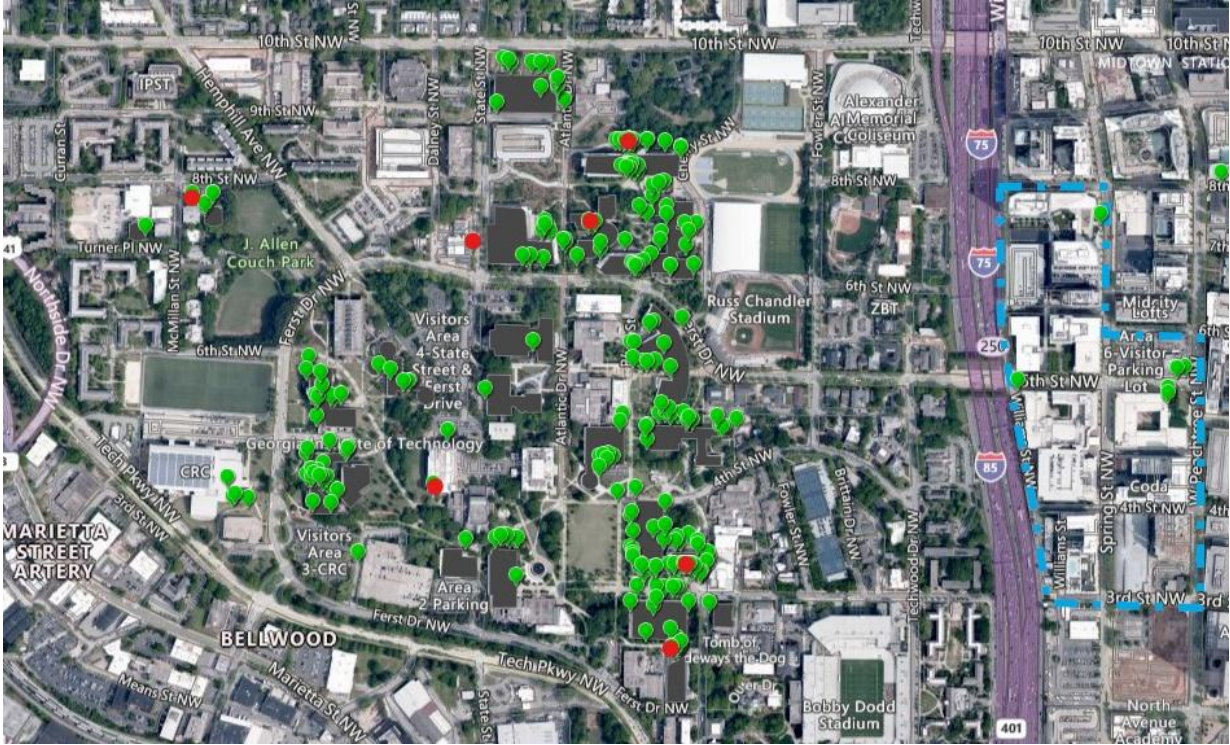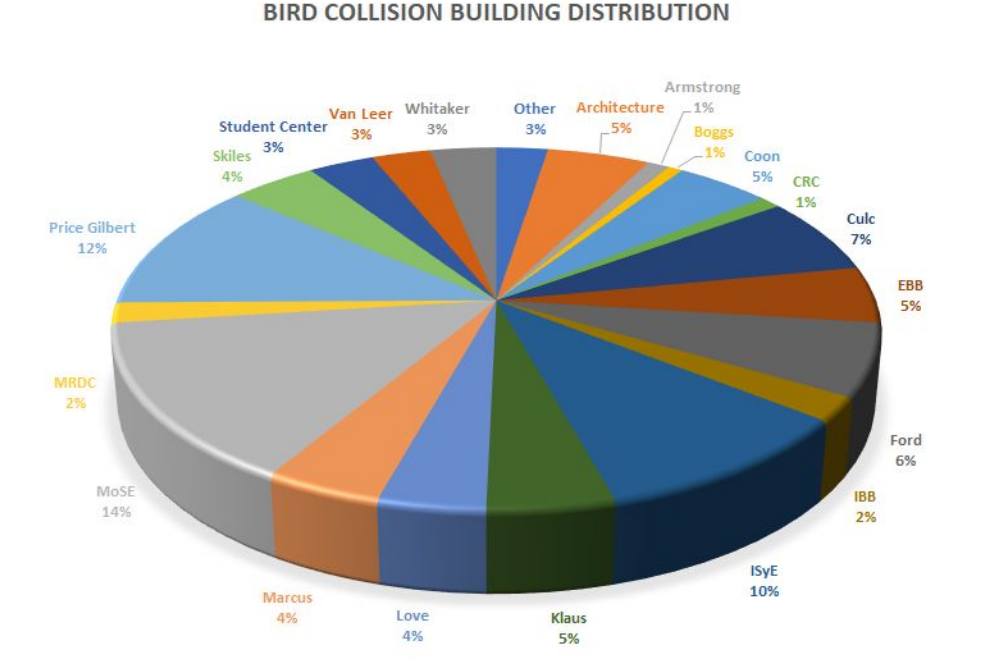Difference between revisions of "Biodiversity"
From Living Building Science
| Line 124: | Line 124: | ||
|- | |- | ||
| Zyra Shahbazi || Biology || Fall 2020 - Present | | Zyra Shahbazi || Biology || Fall 2020 - Present | ||
| + | |- | ||
| + | | Andrew Lenart || Mechanical Engineering || Spring 2021 - Present | ||
|} | |} | ||
Revision as of 14:43, 2 February 2021
Contents
Overview
The purpose of this subteam is to monitor and analyze biodiversity around the Kendeda building and observe different factors that affect wildlife on campus.
For the Fall 2020 semester, we have chosen to focus our efforts on birds. Through bird collision monitoring as well as AudioMoth data, we planned at looking at the current status of the bird population at Tech as well as the different factors affecting it.
Bird Collision Monitoring
Birds are an important element of their respective environments. In addition to the intrinsic significance as well as the cultural value that birds possess, they play a vital role in regenerating habitats by pollinating plants and dispersing seeds. Birds control insect and rodent populations, reducing damage to crops and limiting the transmission of diseases. Unfortunately, there collision with windows poses a great threat to these birds. One-third of all bird species in the United States fall victims to bird collisions. It is the second greatest source of mortality due to human action behind domestic cats. If no action is taken to prevent bird collisions, this will result in a significant decrease in bird populations that will ultimately negatively impact the surrounding community as a whole. As part of Kendeda’s effort to be eco and wildlife-friendly, it makes use of bird-safe glass to help undermine this issue. One third of Kendeda’s windows are bird-safe, and that is predominately at the west side of the building, as opposed to the east side’s windows being non bird-safe. Knowing this, we wanted to see if these bird-safe windows were actually as effective as they claim to be. As such, we wanted to answer the question: “How effective are Kendeda’s bird-safe windows at preventing bird collisions as compared to non bird-safe windows at Kendeda and other buildings on campus?”
Methods
Every weekday around 6:45-7AM beginning 10/5/2020 and ending 11/17/2020, we searched the area around the Kendeda, ISYE, and Price Gilbert buildings for any dead or injured birds. It is important to search up to 30 feet from the building and in any plants, as injured birds may take shelter there. Any birds found are photographed and logged in our iNaturalist project (titled "Bird Collisions GT VIP") and on the Georgia Audubon bird collision map. If any injured birds are found, we would contact Adam Betuel who will arrange transportation to a rehab facility. Birds that we find are also stored in a freezer until they can later be deliver to Adam Betuel.
We got in contact with facilities to get their assistance with recording bird collisions, since they would be able to observe occurrences that we might have missed, picked up before we got to the scene, or happened at times outside our monitoring period. Facilities agreed to notify us of such events by email and were continuously doing so throughout the semester. Their notifications would include a picture of the bird collision, its location, the time that the collision occurred at, and sometimes the species if they were able to identify it.
In addition to our own recordings of the bird strikes, we were also given access to the Georgia Audubon Map of bird collisions around the Georgia Tech campus to add our observations in. We used the map for both recording collisions as well as analyzing previous collisions to get a more accurate representation of bird strikes around campus.
We created an iNaturalist project to maintain our observations in. For each observation, we included the time, place, and species of bird along with a picture of the dead bird. We also created a pamphlet that included information about bird collisions and our own project. We called on readers to help out by sending any bird strike they encounter to our email or uploading it directly to our iNaturalist project. We shared the pamphlet with several organizations, and we received replies from Tech4Wildlife and HumaniTech saying they would pass it along to their members. BBUGS also included our message in their weekly newsletter.
Findings
From 10/5/2020 until 11/17/2020, we have recorded 7 different bird collisions on campus both from our own observations and those notified to us by facilities:
| Date | Species | Location |
|---|---|---|
| 10/02/2020 | Swainson's Thrush | South Side Boggs Building |
| 10/12/2020 | Waterthrush | Front Entrance of Price-Gilbert Library |
| 10/13/2020 | Gray Catbird | Hefner Building |
| 10/15/2020 | Wood Thrush | East Side of Kendeda Building |
| 10/21/2020 | Wood Thrush | Coon Building |
| 10/22/2020 | Yellow-bellied Sapsucker | M.S.& E. Building |
| 10/23/2020 | Wood Thrush | IBB Building |
All of these collisions are significant, but perhaps the most significant observation is the bird collision that occurred near the Kendeda building. This was the first bird collision that had occurred near Kendeda since its opening. At first, this might seem disappointing as it establishes that bird strikes could occur at buildings with bird-safe windows. However, upon further investigation it could be deduced that this collision was not with bird-safe glass but with the regular glass. Kendeda makes use of bird-safe glass, yet it is not completely covered with such glass. The whole east side of kendeda incoporates non bird-safe glass; that was in fact the place at which the bird collision occurred at. This observation does not undermine the importance of bird-safe windows, but strongly reinforces the importance of these windows at their usage throughout the building and not just part of it.
Looking at the places where these collisions occurred, several common factors can be identified that could lead to such strikes. A majority of collisions probably occurred due to the reflection of vegetation on the glass. In addition, most collisions were next to trees. Others occurred due to transparency of the glass.
Through the Georgia Audubon map (pictured above), we were able to record these observations as well as analyze previous bird strikes . The three most common identified species found were the American Robin, Ovenbird, and Wood Thrush.
We have also made a pie graph (included above) of the buildings where bird collisions occurred. The top three building were found to be MoSE, Price Gilbert, and ISyE. Looking more closely at these buildings, they all share common characteristics of high window coverage as well as reflection of surrounding greenery.
Conclusion and Future Research
As no collisions have been observed on the side of Kendeda with the bird safe windows, we can conclude that these windows are effective at preventing bird collisions. Furthermore, they prove to be a good alternative to the traditional windows across campus. In future semesters, the team can continue to monitor bird collisions on campus. However, figuring out where bird collisions occur and why they occur is only a beginning step. Different methods of reducing and preventing bird collisions can be studied and tested. The team can continue to spread awareness about bird strikes, promote the team, and inform people about ways they can help reduce occurrences of bird strikes. Additionally, the team can expand their focus to other wildlife topics and biodiversity projects on campus. We plan to continue with our analysis of the AudioMoth data as well as explore other fields such as the ones mentioned below.
References
Article describing Kendeda's bird-safe glass:
Edelstein , Ken. Kendeda Building's Bird-Safe Glass: Small Step in 'Shockingly Huge' Issue. 1 May 2019, livingbuilding.kendedafund.org/2019/04/26/kendeda-buildings-bird-safe-glass-shockingly-huge-issue/.
Georgia Audubon Map:
National Audubon Society's Mapping Center, audubon.maps.arcgis.com/home/index.html.
Project Safe Flight describing bird collision monitoring around Atlanta:
“Project Safe Flight.” Georgia Audubon, www.georgiaaudubon.org/project-safe-flight.html.
American Bird Conservancy providing information about bird collisions"
“Glass Collisions.” American Bird Conservancy, 29 Apr. 2020, abcbirds.org/program/glass-collisions/.
Utah State's guide to bird collision prevention:
Cowell, Samuel, et al. “Reducing the Risk of Birds Colliding into Windows: A Practical Guide for Homes and Businesses.” Utah State University, Mar. 2017, digitalcommons.usu.edu/cgi/viewcontent.cgi?article=2682&context=extension_curall.
Utah State's research on bird collisions on campus:
Sagers, Rachel, et al. “Patterns of Bird Window Strikes on USU Campus and Physical Features That Increase Risk for Collision.” Utah State University, digitalcommons.usu.edu/cgi/viewcontent.cgi?article=1829&context=researchweek.
Utah State's research involving sensor to monitor bird collisions:
Forero, Leslie. “USU Undergraduate Researcher Creates Sensor To Track When Birds Hit Windows.” UPR Utah Public Radio, 9 May 2019, www.upr.org/post/usu-undergraduate-researcher-creates-sensor-track-when-birds-hit-windows.
American Bird Conservancy's guide about bird collisions:
Seewagen, Chad. L. and Christine Sheppard, 2019. Bird Collisions with Glass: an annotated bibliography. American Bird Conservancy, Washington, DC. 58 pages.
Team Members
| Name | Major | Years Active |
|---|---|---|
| Ghaith Al Tibi | Biology | Fall 2020 - Present |
| Bailey Abel | Biology | Fall 2020 - Present |
| Sara Delawalla | Earth and Atmospheric Sciences | Fall 2020 - Present |
| Zyra Shahbazi | Biology | Fall 2020 - Present |
| Andrew Lenart | Mechanical Engineering | Spring 2021 - Present |

